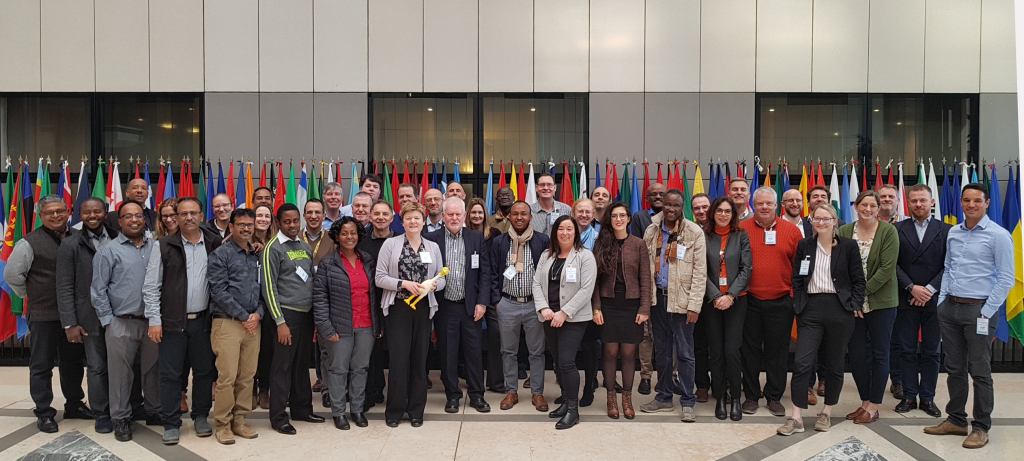Livestock data community deliberates strategies for impact
Report back from LD4D meeting, 4-6 February 2020
by Vanessa Meadu and Karen Smyth (SEBI)
As a global community of practice, Livestock Data for Decisions (LD4D) operates mostly virtually, but the community really comes to life at our annual face to face meeting. This year’s meeting took place in Rome mere weeks before the COVID-19 pandemic was declared. The focus question was how to improve the use of livestock data for a healthier, more resilient and more sustainable livestock sector. The meeting was a unique opportunity to share best practices, reflect on challenges, hear feedback, and propose solutions that can be carried forward by LD4D working groups.
We were fortunate to be able to meet in person, and look forward to carrying out next steps through virtual collaboration.
Meeting documentation

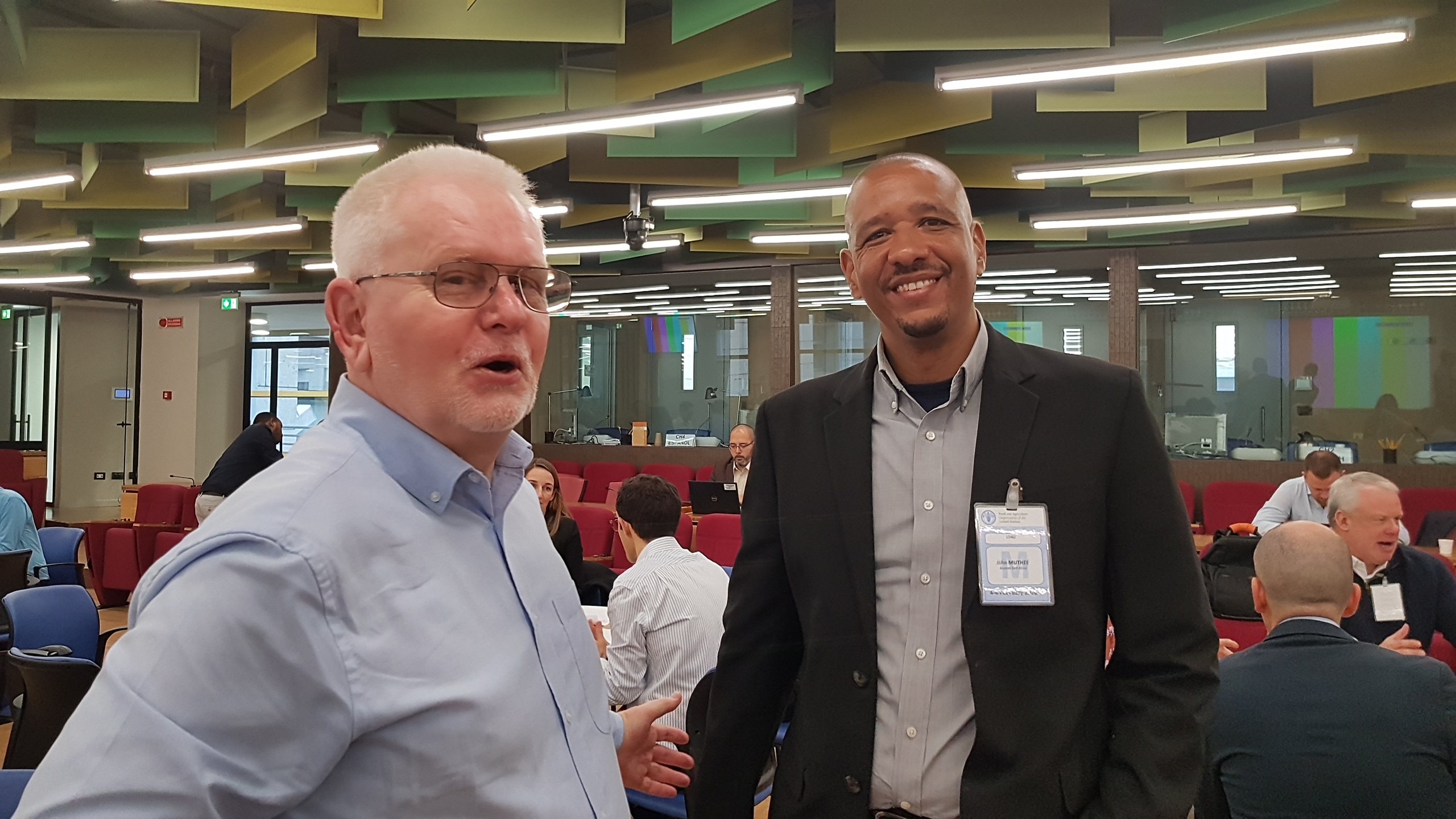

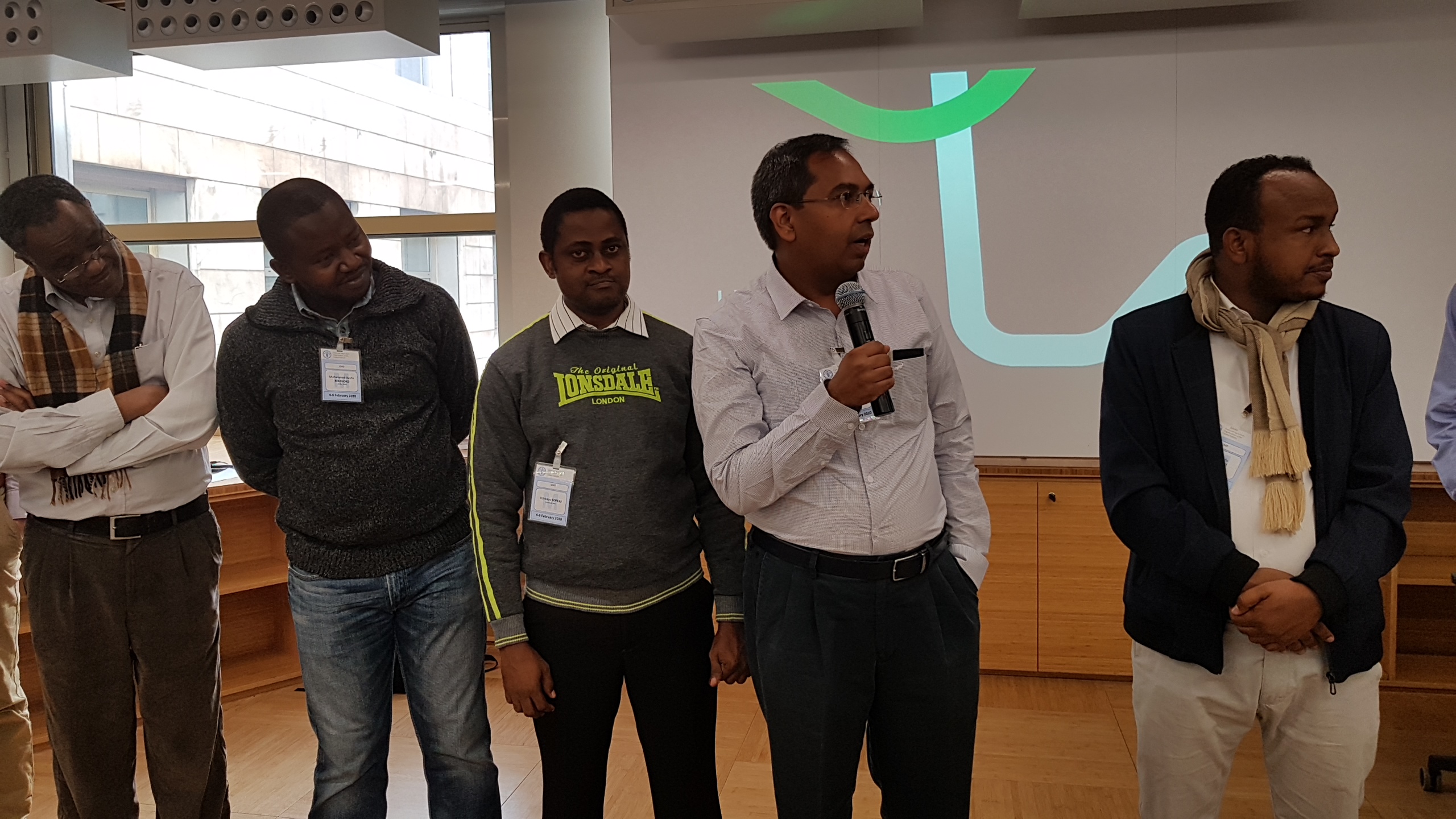

Seventy-five community members met in Rome from 4-6 February 2020, for the meeting, which was hosted by the UN Food and Agriculture agency (FAO). Conversations considered whether the livestock sector is anticipating change and doing enough to meet future challenges. The meeting centred on strategies for improving data generation and use, with a special focus on making the most of FAO’s livestock data.
As with past meetings, this gathering offered a platform for participants to share their diverse experiences and expertise.
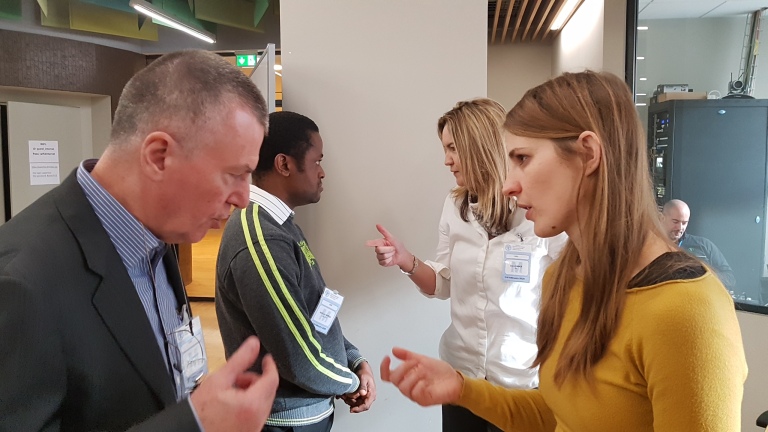
Looking into the livestock crystal ball
What does the future hold? In this session, researchers from leading institutes shared their analysis of future livestock trends such as demand for meat and climate impacts on food production. Through this kind of work the global community can begin to grasp future opportunities and challenges in the sector order to take appropriate action.
The first step is to understand what targets we are trying to reach so we can identify credible strategies to get there. Presentations also underscored the need to better understand behavioural change in the sector and it was proposed that the community engage with behavioural scientists. Another suggestion was to better link recommendations to decision-support tools.
Watch session video
How do we track changes in the livestock sector over time?
The FAO has created an extremely valuable asset through its work to collect and analyse livestock data over time. This diverse range of longitudinal datasets are being used to inform responses to disease outbreaks, are shaping actions to end hunger and poverty, and helping improve the knowledge base on animal health. Many of the datasets are built collaboratively with global partners, and rely on primary country-level or household level data. However, there are long-standing challenges in capturing reliable data, especially in informal settings such as pastoralist systems. There are also many questions on the quality of existing data. FAO and its partners are interested in ways to improve data quality, and encourage greater use of its datasets as they become more open and interoperable.
Watch session video
“Cattle Mart” showcase of livestock data solutions and innovations
[click to access all Cattle Mart presentations]
In this interactive session, community members demonstrated how technology applications are supporting livestock health and productivity Low and Middle-Income Countries. The session was introduced by a presentation on the use of the Internet of Things (IoT) in India’s dairy value chain, given by Venkatesh Seshasayee, Chief Architect, Stellapps (presentation PDF). Community members presented innovations such as farmer-facing apps, better data collection approaches, to sector-level innovations, and mathematical/modelling techniques for improving livestock research.

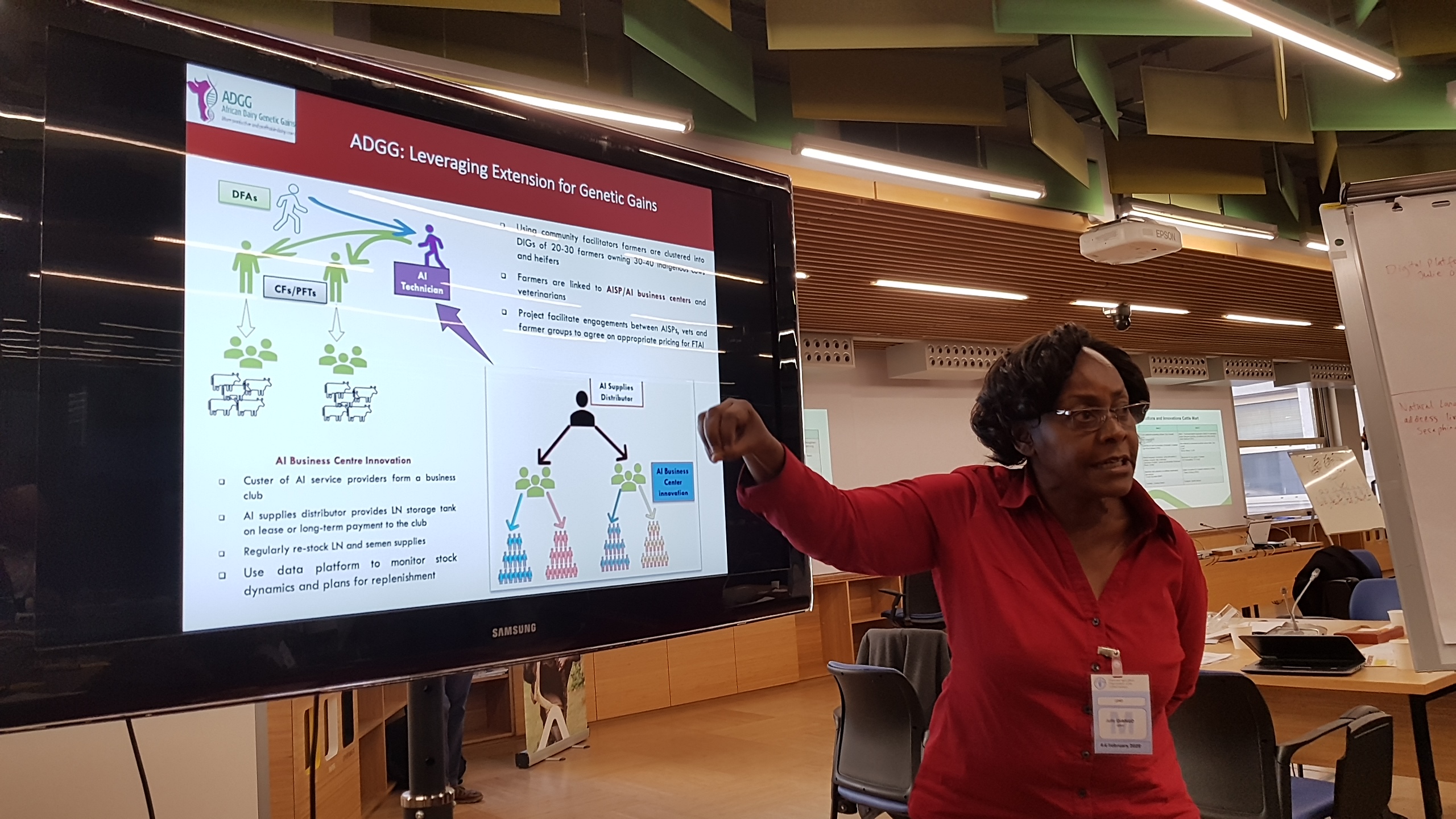


How do we use data to plan future livestock initiatives?
Given what we know about future trends in the livestock sector (see Session 1), how can we ensure that plans and investments make use of the best available evidence? This session shared views from researchers, country-level initiatives and donors on how to balance between future and current needs to ensure long-term sustainable livestock development.
A key finding is that livestock productivity in LMICs has improved only minimally, in spite of all the investment in the sector. Participants agreed that strategies and master plans are critical but they must be based on better data and models, and consider trade-offs (for example between production targets and climate commitments). Policies are often made for political reasons, and data may be used in an ad-hoc fashion. If the livestock sector truly wish to set and reach targets at a “national” level, the livestock data community may need to intervene on a much larger scale or combine multiple interventions to increase impact.
Watch session video
How do we measure our impact?
Livestock project implementers and their funders are working hard to measure the impacts of their work. To do this well, we need to clearly define the scope of what we want to achieve, and set simple and clear indicators that can aggregate to a higher level.
In this session, presenters shared methods and experiences to track impact at different scales. Projects need to understand how their work is having an impact on the ground, in order to refine and improve their activities. Meanwhile, investors such as the Bill and Melinda Gates Foundation (BMGF) and bilateral agencies like USAID need to understand whether their portfolio of projects are achieving their intended impacts. At the same time, countries and international agencies are increasingly interested in tracking indicators for livestock health, such as mortality, but new analysis shows that standardised mortality rates are almost impossible to generate and it may be more useful to look at disease outbreaks as an alternative indicator. Finally, we need systems to track how sustainable livestock are contributing to the sustainable development goals (SDGs), especially as livestock may impact positively on one goal (such as reducing hunger) while generating negative impacts on others, for example, human health or climate change. Measuring impact is challenging and deserves more attention if we are to truly understand the impact of investments.
Watch session video
Working group updates and next steps
Through its working groups, LD4D community members cooperate on strategic activities and outputs. The meeting allowed current working groups to take stock of ongoing work, and gave community members the opportunity to explore possible new areas for collaboration. There was clear demand for some new working groups. Moving forward, the working groups should be the engine for LD4D to deliver new insights and thinking, and the secretariat will need to explore how to properly fund this kind of work as part of the new LD4D 5-year plan.
WG Livestock ontologies
This current working group was set up to find ways to present and organise livestock data in a consistent manner. The group’s main function will be to support knowledge sharing among the community, help connect on-going initiatives, and support the development and promotion of best practices.
Next steps: develop a draft vision and goals for the working group, mapping expertise and data domains, and proposing some technical options to link together current and emerging vocabularies and ontologies.
- Read more: discussion summary (PDF)
- WG contact: Vanessa Meadu (SEBI)
WG Livestockdata.org
Currently under development, Livestockdata.org will be a platform for evidence generated through the LD4D community, as well as useful evidence from other expert sources. Community members previewed the website and gave helpful feedback on how to best add value to existing data and resources. Discussions highlighted the importance of partner contributions to the site and the value of making data open, reusable, and easy to embed on other websites.
Next steps: the site will go live in May 2020 and a series of virtual events will be organised to share new content and tools with the community
- Read more: discussion summary (PDF)
- WG Contact: Gareth Salmon (SEBI)
WG Evidence for advocacy: GLAD and Key Livestock Facts
The Global Livestock Advocacy for Development (GLAD) project, led by the International Livestock Institute, is interested in using data and evidence produced by LD4D for its activities. The LD4D Livestock Facts project has over the years generated eight factsheets as well as a peer reviewed journal article, to help uncover the data behind popular livestock claims. The WG discussed how to better link these two initiatives, whether to develop specific visualisations and evidence for key events and debates in the coming year, and the best ways to tell stories founded in data.
Next steps: explore developing evidence for particular solutions, explore whether to do new factsheets on topics like nutrition and gender, and consider a joint event or campaign in 2020.
- Read more: discussion summary (PDF)
- WG Contact: Michael Victor (ILRI) and Gareth Salmon (SEBI)
WG Data quality
This ongoing working group is concerned with improving the quality of primary livestock sector data, i.e. data collected by national governments that forms the basis of FAO, OIE and other international datasets. It also includes data that research groups, project implementers and the private sector collect for their own use. The group discussed challenges and weaknesses with current approaches, and pointed to possible improvements through better metadata, peer ratings, training and harmonisation of methods.
Next steps: Although firm steps were not set out for this group, LD4D will continue to improve data quality through its development of livestockdata.org.
- Read more: discussion summary (PDF)
- WG Contact: Anni McLeod / Karen Smyth (SEBI)
WG Understanding market potential
This was a new working group discussion based around the possible development of a model to assess the future market potential for animal health products in Africa. Such a model would help donors better judge gaps and opportunities, and provide new insights to the animal health industry in terms of new investment opportunities. The working group looked at the building blocks for such a model, including species covered, production systems to include, diseases, and product availability.
Next Steps: Luc Dumand to seek further input as necessary.
- Read more: discussion summary (PDF)
- WG Contact: Luc Dumand
WG Setting targets
This potential new group discussed how to set targets for the sector and what methodology could be used to increase productivity in a sustainable manner. Different systems and scales will require different approaches to target setting. A key question is whether targets should be based on a continuation of the previous trajectory or should they take into account wider sustainable development goals and move livestock systems towards new trajectories. Doing so would require taking into account the various trade-offs, for example low-income systems need to improve output while middle-income systems are concerned more with improving efficiency. Livestock Master Plans (LMPs) are seen as an important entry point and the group questioned the way in which the plans are developed, funded and the potential counterfactuals associated with the implementation of a plan’s activities. A main question is how these plans align with global sustainability criteria and national and international climate change targets.
Next steps: BMGF will explore if there are opportunities for greater transparency and communication between the LMP development process and LD4D modelling experts.
- Read more: discussion summary (PDF)
- WG contact: Karen Smyth (SEBI)
WG Pastoralist data
This potential new group would discuss the challenges around marginalisation of the pastoralist sector, due in part to false narratives and sub-optimal public and private sector investment. They identified a number of current issues that need to be addressed including reversing the narrative, improving primary data collection, understanding the needs of the target groups, better knowledge exchange between groups and better rangeland management. Better collaboration is needed between countries and regional bodies, and better inclusion of pastoralists is needed in broad-based livestock discussions.
Next Steps: the group could work on improving data, better messaging to stakeholders about the importance of pastoralists, and a meta analysis of existing data.
- Read more: discussion summary (PDF)
- WG Contact: Andrew Bisson (USAID)/Karen Smyth (SEBI)
WG The future of food and agriculture: holistic scenarios and data requirements for livestock
This group explored potential work around future-proofing livestock. There is a clear need for better data and understanding on livestock, greenhouse gases, and climate change, especially around opportunities and trade-offs in LMICs. A second area of work is around target setting, and ensuring targets are realistic and take into account barriers to uptake and challenges around behaviour change. Targets need to be prioritised and well-justified in terms of impacts on profit, animal welfare and environment.
Next steps: although no next steps were set out, this is a discussion LD4D will progress with BMGF.
- Read more: discussion summary (PDF)
- WG Contacts: Lorenzo Bellu (FAO) and Dominik Wisser (FAO consultant)
WG Natural language processing – using informatics to address livestock data challenges
Participants explored opportunities to utilise data analytics to collate and generate data. This informal discussion was led by data scientists from university of Edinburgh.
Next steps: although no next steps were set out, this is a discussion LD4D will progress.
The future of LD4D
In a feedback session, community members showed strong support for focusing future efforts on areas that LD4D has not yet specifically addressed, such as strengthening engagement with the public and private sectors, scaling up investments for impact, and data around pastoralist communities. Other areas that merit some analysis are the One Health domain, and improving public sector engagement on livestock data issues.
To engage with these topics, the community would need to reach out to new expert and stakeholder groups, and find ways to sustainably fund future working group efforts. We will try to address resourcing challenges in the next round of funding.
LD4D was designed largely as an experiment which aimed to bring a range of livestock experts from varying backgrounds together to address livestock data challenges. Together we have grown from a small group of strangers from different backgrounds and disciplines to a more confident cohort of colleagues who better understand the complexities and challenges that each other face. We have navigated difficult topics to come up with solutions to meet the needs of the community, for example by setting up a meta data platform of grantees projects rather than warehousing grantees primary data.
The community has had successes, such as the Key Livestock Facts journal paper which was widely acknowledged as a valuable contribution but we also face challenges and have not met our full potential in terms of what we can achieve together as a community. Although LD4D is still evolving and finding its place, we appreciate the support of the community in backing this initiative for what it has and might be able to achieve. We are currently draw up the LD4D’s 5-year strategy and we look forward to receiving your feedback on future plans.
The authors are staff members of Supporting Evidence Based Interventions, based at the University of Edinburgh’s Royal (Dick) School of Veterinary Studies. SEBI facilitates the Livestock Data for Decisions (LD4D) community of practice.
Photo credit: SEBI (see flickr gallery)
April 1, 2020
Vanessa Sebi

